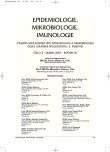Urinary Tract Infections in Children Caused by Uropathogenic Strains of Escherichia coli and the Role Of The Innate Immune Response Mediated by the Toll-like Receptor 4 and Antimicrobial Peptide Cathelicidin in their Clinical Course
Infekcie močových ciest u detí spôsobené uropatogénnymi kmeňmi Escherichia coli a vplyv vrodených imunitných mechanizmov Toll-like receptora 4 a antimikróbneho peptidu katelicidínu, na ich klinický priebeh
Pôvodcami infekcií močových ciest (UTI) sú najmä uropatogénne kmene Escherichia coli (UPEC), ktoré sa detekujú vo viac ako 80 % prípadov. Baktérie sa dostávajú do bezmikróbneho prostredia, v ktorom môžu spôsobiť akútne, potenciálne život-ohrozujúce infekcie, ktoré často prechádzajú do chronicity. Priebeh týchto infekcií nezávisí iba od patogéna (napr. UPEC), ale aj od aktivácie obranných mechanizmov. Významná rozpoznávacia a aktivačná funkcia je pripisovaná nedávno objaveným Toll-like receptorom a katelicidínu.
Kľúčové slová:
infekcie močových ciest – uropatogénne E. coli – Toll-like receptor 4 – katelicidín.
Authors:
A. Liptáková 1; Podracká; Ľ. 2; L. Siegfried 1
Authors‘ workplace:
Ústav lekárskej mikrobiológie LF UPJŠ Košice
1; 1. Klinika pre deti a dorast LF UPJŠ Košice
2
Published in:
Epidemiol. Mikrobiol. Imunol. 56, 2007, č. 2, s. 72-77
Overview
Uropathogenic Escherichia coli (UPEC) are the causative organisms in more than 80% of urinary tract infections. The bacteria are introduced to the urinary tract that, except for the external part of the urethra, is free from microbial colonization, and thus can cause acute, potentially life-threatening infections with possible progression to chronic disease. The course of such infection depends not only on the agent involved but also on the activation of protective mechanisms. The recently described Toll-like receptor family and antimicrobial peptide cathelicidin appear to play an important role in the recognition and activation functions.
Key words:
urinary tract infections – uropathogenic Escherichia coli – Toll-like receptor 4 – cathelicidin.
Labels
Hygiene and epidemiology Medical virology Clinical microbiologyArticle was published in
Epidemiology, Microbiology, Immunology

2007 Issue 2
Most read in this issue
- Monitoring Genes Encoding Panton-Valentine Leukocidin in Staphylococcus Aureus Strains
- Pertussis: a Reemerging Infection?
- Effectiveness of Aerial Application of VectoBac G Larvicide Granules Against Mosquitoes in the Olomouc Region in Spring 2006
- Clinical Specimens for PCR Detection of Syphilis
